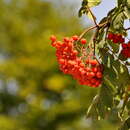Biology
provided by Arkive
Seed production begins when the tree is about 15 years old. Flowers blossom in May or early June, attracting pollinating insects, including many species of flies, bees and beetles. In mild climates rowan will fruit each year, but in harsher environments, like Glen Affric in Scotland, fruiting is irregular. The berries, which ripen to a bright red colour in August, provide a soft and juicy food for birds such as chaffinches (Fringilla coelebs), siskins (Carduelis spinus), and blackbirds (Turdus merula), which then distribute the seeds in their droppings. Cold weather is required to crack and break down the tough coat of the rowan seed, and germination usually takes place in the first or second spring after the berries have been produced. Rowan trees can live up to an impressive 100 years or more (2).
Conservation
provided by Arkive
Conservation action is not required for this species at present.
Description
provided by Arkive
Rowan is one of the most familiar wild trees in the British Isles, recognised for its distinctive red berries, which inject a splash of colour into the landscape from mid summer through to late autumn (4). Rowan is a typically small and slender tree with a greyish-brown bark. The leaves are made up of matched pairs of leaflets on either side of a stem, with a terminal leaflet at the end. A deciduous tree, rowan sprouts new leaves in April, which later turn a stunning bright orange-red colour in autumn before being shed. The dense clusters of creamy-white flowers that blossom in spring possess a distinctive strong, sweet scent (2). Rowan has received an assortment of common names, but easily the most deceptive is that of “mountain ash”, which incorrectly implies that it is a species of ash (Fraxinus). Rowan is in fact a member of the rose family (Rosaceae), and this misleading name has arisen only due to a superficial similarity in leaf shape of the two trees and an overlapping range (5).
Habitat
provided by Arkive
This hardy tree inhabits cool to cold climates (7). It is able to grow at the most northerly limit of trees in Europe, at latitude 70° north, and is recorded at elevations of up to 2,000m in France (2). Rowan prefers well-drained, peaty soils (7) but is adaptable; in Scotland it is often found in inaccessible locations such as cliffs, steep stream-sides and on top of large boulders, where it is able to grow out of reach of herbivores like red deer (Cervus elaphus) (2).
Range
provided by Arkive
Rowan is most commonly found in the west and north of Britain but is native throughout Britain and Ireland, as well as Europe, North Africa, and Asia Minor (6).
Status
provided by Arkive
Classified as Least Concern (LC) in the British Red Data Book, indicating that rowan is widespread and abundant (3).
Threats
provided by Arkive
This species is not currently threatened.

